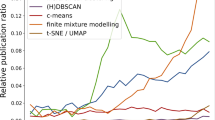Abstract
When a simple random sample of size n is employed to establish a classification rule for prediction of a polytomous variable by an independent variable, the best achievable rate of misclassification is higher than the corresponding best achievable rate if the conditional probability distribution is known for the predicted variable given the independent variable. In typical cases, this increased misclassification rate due to sampling is remarkably small relative to other increases in expected measures of prediction accuracy due to samplings that are typically encountered in statistical analysis.
This issue is particularly striking if a polytomous variable predicts a polytomous variable, for the excess misclassification rate due to estimation approaches 0 at an exponential rate as n increases. Even with a continuous real predictor and with simple nonparametric methods, it is typically not difficult to achieve an excess misclassification rate on the order of n −1. Although reduced excess error is normally desirable, it may reasonably be argued that, in the case of classification, the reduction in bias is related to a more fundamental lack of sensitivity of misclassification error to the quality of the prediction. This lack of sensitivity is not an issue if criteria based on probability prediction such as logarithmic penalty or least squares are employed, but the latter measures typically involve more substantial issues of bias. With polytomous predictors, excess expected errors due to sampling are typically of order n −1. For a continuous real predictor, the increase in expected error is typically of order n −2/3
Similar content being viewed by others
References
1 Anderson, T.W., & Rubin, H. (1956). Statistical inference in factor analysis. Proceedings of the Third Berkeley Symposium, Vol. 5, pp. 111–150.
2 Apostol, T.M. (1967). Calculus (2nd ed., Vol. 1). New York: Wiley.
3 Bartlett, M.S. (1937). The statistical conception of mental factors. British Journal of Psychology, 28, 97–104.
4 Bekker, P.A., Merckens, A., & Wansbeek, T.J. (1994). Identification, equivalent models, and computer algebra. Boston: Academic Press.
5 Browne, M.W. (1984). Asymptotically distribution-free methods for the analysis of covariance structures. British Journal of Mathematical and Statistical Psychology, 37, 62–83.
6 Dijkstra, T.K. (1981). Latent variables in linear stochastic models. Amsterdam: Sociometric Research Foundation.
7 Ferguson, T.S. (1996). A course in large sample theory. London: Chapman & Hall.
8 Green, B.F. (1969). Best linear composites with a specified structure. Psychometrika, 34, 301–318.
9 Guttman, L. (1955). The determinacy of factor score matrices with implications for five other basic problems of common-factor theory. British Journal of Statistical Psychology, 8, 65–81.
10 Hayashi, K., & Bentler, P.M. (2000a). On the relations among regular, equal unique variances and image factor analysis. Psychometrika, 65, 59–72.
11 Hayashi, K., & Bentler, P.M. (2000b). The asymptotic covariance matrix of maximum-likelihood estimates in factor analysis: The case of a nearly singular matrix of estimates of unique variances. Linear Algebra and its Applications, 321, 153–173.
12 Holzinger, K.J., & Swineford, F. (1939). A study in factor analysis: The stability of a bi-factor solution. Supplementary Educational Monographs, No. 48. Chicago: University of Chicago Press.
13 Horn, R.A., & Johnson, C.R. (1985). Matrix analysis. Cambridge: Cambridge University Press.
14 Jöreskog, K.G. (1969). A general approach to confirmatory maximum likelihood factor analysis. Psychometrika, 34, 183–202.
15 Kano, Y. (1983). Consistency of estimators in factor analysis. Journal of the Japan Statistical Society, 13, 137–144.
16 Kano, Y. (1984). Construction of additional variables conforming to a common factor model. Statistics & Probability Letters, 2, 241–244.
17 Krijnen, W.P. (2002). On the construction of all factors of the model for factor analysis. Psychometrika, 67, 161–172.
18 Krijnen, W.P. (2004). Convergence in mean square of factor predictors. British Journal of Mathematical and Statistical Psychology, 57, 311–326.
19 Krijnen, W.P., Wansbeek, T.J., & Ten Berge, J.M.F. (1996). Best linear predictors for factor scores. Communications in Statistics: Theory and Methods, 25, 3013–3025.
20 Lawley, D.N., & Maxwell, A.E. (1971). Factor analysis as a statistical method (2nd ed.). Butterworth: London.
21 Lee, S.Y., & Poon, W.Y. (1995). Estimation of factor scores in a two-level confirmatory factor analysis model. Computational Statistics & Data Analysis, 20, 275–284.
22 Lehmann, E.L. (1999). Elements of large sample theory. New York: Springer-Verlag.
23 Lord, M., & Novick, M.R. (1968). Statistical theories of mental test scores. Reading MA: Addison-Wesley.
25 McDonald, R.P. (1981). Constrained least squares estimators of oblique common factors. Psychometrika, 46, 337–341.
24 McDonald, R.P., & Burr, E.J. (1967). A comparison of four methods of constructing factor scores. Psychometrika, 32, 381–401.
26 Neudecker, H. (2004). On best affine unbiased covariance-preserving prediction of factor scores. Statistics and Operations Research Transactions, 28, 27–36.
27 Rao, C.R. (1973). Linear statistical inference and its applications. New York: Wiley.
28 Rao, C.R., & Toutenburg, H. (1995). Linear models. New York: Springer-Verlag.
29 Rudin, W. (1976). Principles of mathematical analysis (3rd ed.). New York: McGraw-Hill.
30 Schneeweiss, H. (1997). Factors and principal components in the near spherical case. Multivariate Behavioural Research, 32, 375–401.
31 Schneeweiss, H., & Mathes, H. (1995). Factor analysis and principal components. Journal of Multivariate Analysis, 55, 105–124.
32 Skrondal, A., & Laake, P. (2001). Regression among factor scores. Psychometrika, 66, 563–576.
33 Steiger, J.H. (1979). Factor indeterminacy in the 1930's and the 1970's: Some interesting parallels. Psychometrika, 44, 157–167.
35 Ten Berge, J.M.F. (1983). On Green's best linear composites with a specified structure, and oblique estimates of factor scores. Psychometrika, 48, 371–375.
34 Ten Berge, J.M.F., Krijnen, W.P., Wansbeek, T.J., & Shapiro, A. (1999). Some new results on correlation preserving factor scores prediction methods. Linear Algebra and its Applications, 289, 311–318.
36 Wang S.G., & Chow, S.C. (1994). Advanced linear models. New York: Marcel Dekker.
37 Williams, J.S. (1978). A definition for the common-factor analysis model and the elimination of problems of factor score indeterminacy. Psychometrika, 43, 293–306.
Author information
Authors and Affiliations
Corresponding author
Rights and permissions
About this article
Cite this article
Haberman, S.J. Bias in Estimation of Misclassification Rates. Psychometrika 71, 387–394 (2006). https://doi.org/10.1007/s11336-004-1145-6
Received:
Accepted:
Published:
Issue Date:
DOI: https://doi.org/10.1007/s11336-004-1145-6




